
Exeter's Fire Brigade
Page added 5 May 2009
If ever a city was in need of an efficient and modern fire service, it was Exeter, for in 1887, the city was reeling from one of the most deadly fires ever recorded in the Britain. As early as 1626 Exeter had employed a machine designed for putting out fires. The crude and heavy pumping engine was kept in the Guildhall from where it was carried to the fire. When thatch or chimney or kitchen caught fire, it was to the bucket and crook that most citizens rushed, throwing water as best they could on the burning building, or dragging the thatch off the roof to prevent the fire spreading to adjacent structures.
Heavy fines were imposed on any citizen who allowed their chimney to catch fire because of the danger of a conflagration spreading to neighboring properties. By the nineteenth century Exeter had attracted the dubious nomenclature of 'fiery city'. The introduction of fire insurance with the West of England Fire Insurance Company, Sun Insurance Office and Norwich Union Life Insurance Society gave some protection to those who could pay, and brass signs denoting insurance cover from one of the companies appeared on the front of many buildings in the city. James Golsworthy who ran the water engine to supply water to the city installed the first fire plugs in his mains in 1822 at the behest of the West of England.
Tragedy at the Theatre Royal
On the 5th September 1887, during the first night of a romantic comedy called Romany Rye at the Theatre Royal, for an audience of 800, a naked flame ignited some drapes in the fly's high above the stage. Within moments, panic broke out as the flames spread. Despite the valiant efforts of the West of England Insurance Co., fire brigade, based just a hundred yards from the theatre, using the "Little West" fire engine, the flames spread through the building. By 1am the next morning, 106 bodies lay in the New London Inn stables. In total 186 died that night, despite the heroic efforts of police, soldiers, firemen, and many civilians to save life. The city was in shock and an inquiry held to ascertain the cause, and discover the deficiencies in the building and fire fighting. Also see Theatre Fire and Theatre Fire Graphics.
Advice from the Chief Constable
The City Council asked Constable Captain Eyre Shaw, who had held the enquiry into the fire, to recommend improvements for fire fighting in the city. He suggested a City Fire Brigade, paid for and controlled by the Council, and on the 28 September 1887 it was proposed a Fire Brigade be formed with the Chief Constable in charge; on the 27 October, the Chief Constable Captain Edward Shower presented a list of equipment and staff for the new brigade. He turned down the position as Superintendent and the Committee decided to advertise the position.
In January 1888 a short list of four was drawn up for the position of Superintendent, and after the interviews, Mr William Pett of Sevenoaks was appointed. Arrangements were quickly made to appoint suitable men to man the brigade – they had to be between 18 and 40 years of age, with a minimum height of 5ft 7in (1.7 metres). On the 20 February, the Committee were informed that 44 men had applied, and 38 attended interview – a sub-engineer and foreman were appointed, along with sixteen firemen, two messengers and a Brigade Surgeon. The next day, the Committee visited the fire station belonging to the West of England Insurance Company in New North Road and accepted the offer from the company to purchase the premises. Both the West of England and the Sun Insurance companies had already donated their manual engines and curricle escapes to the Council for the new brigade. Twenty street alarms were installed around the city and all was set for the brigade to be formed on 1 March 1888 as the Exeter City Fire Brigade.
On the 10 April, the first call out for the fledgling service was to a fire in King Street which was subdued at a cost of £3 10s. A fortnight later Pett presented his first report to the Committee; they had been called out 29 times for 5 alarms, 8 chimneys and 16 fires (12 slight damage, 4 serious). The total loss was £1,944 at a cost of £36 7s 10½d to the brigade.
Superintendent Pett led his men from the front, and was very competitive – in June 1893 he was national champion for the single-man fire-engine drill. In the same year at the Grand International Fire Tournament and Exhibition, his brigade won the International Challenge Trophy outright; the solid silver cup is on exhibit in the Guildhall. In 1896, at the annual Exeter Fire Brigade Competition, Superintendent Pett was first in the single man, manual engine drill with a time of 50.5 seconds, followed by fireman Winsborrow with a time of 53.25 seconds.
A New Century
The City Fire Brigade still relied on horses as the first petrol driven motor cars appeared on the streets of Exeter. Probably the first time the brigade was called out to a motor vehicle, albeit an electric car, was in December 1900, when Mr Reid, a watchmaker of Sidwell Street attempted to charge his battery powered car. A spark caused the vehicle to ignite and a fire ensued. Superintendent Pett and the fire brigade arrived to burst open the door of the building and drag the car outside, before extinguishing the flames. The car was a total loss at an estimated cost of £150.
A major fire in Sidmouth during 1902 resulted in an urgent call to Pett's men for reinforcements as the local Sidmouth brigade could not cope with a fire spreading through the commercial part of the seaside town. The inadequacy of horses for a quick response was amply demonstrated as the Superintendent tried, without success, to charter a special train for his horses and equipment to Sidmouth. He then arranged for his own team of horses to pull the 'steamer' as far as Newton Poppleford where a team of horses from Sidmouth would take over. The original call came in at 12.50am, and the brigade arrived at 11.30am just over ten and half hours later.
The brigade was kept busy throughout the period before the outbreak of the First War with both mundane domestic fires and dangerous conflagrations that threatened life. Probably the largest fire they had to deal with was at Sharpe's Timber Yard off Queen Street next to the London and South Western Railway yard on the 1 June 1910. For twenty hours the brigade fought a fire that spread to Bass, Ratcliff and Gretton, Hibberd and Co and G Heywood and Sons; the City Hotel was also damaged, as well as the railway line.
One incident at the Exeter Gas Light & Coke Co., in the first few years of the century resulted in the first death of a City Brigade fireman. A fire at the coke dump was fought overnight and at 7am Superintendent received a call at the station that one of his men had been overcome by fumes - attempts to revive Fireman Seage lasted an hour before he was declared dead.
The first 'motor pump'
It wasn't until January 1914 that the City Fire Brigade took delivery of its first petrol engined fire appliance, when FJ450, a Merryweather vehicle, was delivered and adapted to tow the old steam driven 'Devonia'. The new appliance was named 'Exonia' by the Mayoress Mrs. K King, in a public display, at the Rougemont Hotel. In 1921, a an ex War Department Fiat chassis was purchased from Yeo and Davey for £495. The Brigade built the coachwork for the chassis, and added the hose and ladders. Three years later, FJ2939, a motor pump was added to the fleet replacing the elderly 'Devonia' steam pump.
At 5:10am on the 6 October 1919 Superintendent Pett took a call at the Fire Station reporting a fire at the Victoria Hall in Queen Street. When the brigade arrived flames and sparks were leaping from the roof, and units from St Thomas, Heavitree, Exwick, Whipton and Wonford were quickly called to help. Water jets were directed at the eaves of the roof of the adjacent Rougemont Hotel to prevent it catching fire. The value of the loss of the hall amounted to £6,000.
Superintendent William Pett, the father of the Exeter City Fire Brigade retired in May 1927 after 39 years service. He died on 15 July 1934 and was buried in Higher Cemetery with an appropriate gravestone of a fireman's helmet and crossed firemen's axes.
The new Chief Fire Officer was Mr F Richards who immediately increased the full time firemen from four to six and in 1928, scrapped Pett's street fire alarms. It was apparent that the old fire house in New North Road was too small for the expanded brigade, while the quarters for the Chief Fire Officer were said to be shameful.
A Move to a New Fire station
The Council Committee considered several sites for a new fire station, finally selecting a site of one and a half acres at Danes Castle, beside the already existing reservoir of the water company. On 25 November 1931, the foundation stone was laid by the Mayor Mr H W Michelmore and work commenced to build a purpose designed building for the Brigade. This was a time of high unemployment, and the construction gave work to a substantial number of men in the city; another scheme at the time to build a new sewage works below Countess Wear bridge also employed a high number of workers. The new fire station cost £16,640 and on the 25 July 1932 it was opened by Mayor Michelmore. The old firehouse in New North Road was auctioned by Hussey and Sons for £1,500. It is now the Old Fire House bar and restaurant.
The Council minutes list month by month the call out of the service through the 1930s – some months only minor incidents occurred, and other months a major incident would be dealt with. Cricklepit Mill suffered a major fire, and the ice-factory in the old Powhays Mill premises in Bonhay Road was badly damaged in November 1936.
The Blitz
Exeter's fire service was allocated 10 emergency pumps by the Home Office in 1939 in preparation for war. On the 10 April 1940 Chief Officer F Richards died after 13 years running the brigade, and H G P Coles from the Hornsey Fire Brigade replaced him. In 1941, the countries many brigades were nationalised and merged into the National Fire Service (NFS). Temporary water tanks were placed around the city - the central garden in Southernhay was one location for a large surface tank, and the moat of Rougemont Castle was dammed to create another. In addition a large pool of water on the old brick works at Clifton Hill was utilised, and even the new City Swimming Baths were earmarked for tapping in case of emergency.
Out of a total of 19 air raids on Exeter during the war, the raid of 4 May 1942 tested Exeter's fire service the most. During the raid, the city was divided into five zones, and the fire officer for each zone reported to the Chief Regional Fire Officer at St Anne's Fountain by the junction of Sidwell Street and Blackboy Road. Reinforcements from as far as Reading were called in to fight the fires raging through the city's many old buildings – more property was lost through fire after the raid, than by blast damage during it. It wasn't until 12.30 on the 7th May that all reinforcements were stood down - 195 Reinforcing Pumps and 1,080 personnel were used during the raid and aftermath to fight the many fires. See Exeter's blitz for the story of the part that the fire service took in fighting the fires.
Leading Fireman W M Hall received the British Empire Medal for his deeds that night, while Leading Firemen L J Gould, F W Wilson and A W Matthews were Commended for Brave Conduct.
A peacetime fire service
On 1 April 1948, the National Fire Service was disbanded and the Exeter City Fire Brigade taken back under the control of the City Council. The National Fire Service flag was lowered and the City of Exeter pennant raised at a ceremony attended by the Mayor and other dignitaries. The reconstituted service now had 46 full-time fire fighters with a further 20 retained men. Mr S F Willey was appointed as Chief Officer at the same event.
Nineteen years later on the 8 October 1967, Chief Fire Officer Willey retired to be replaced by Mr D G Varnfield, formerly Deputy Chief Officer of Coventry Fire Brigade. The City of Exeter Fire Brigade was amalgamated with the Devon Fire and Rescue Service in 1974 after local boundary changes – this was the end of the proud City of Exeter Fire Brigade after its formation 84 years earlier following the tragic Theatre Royal fire.
Note – Exeter is currently the responsibility of the Devon and Somerset Fire and Rescue Service based at Clyst St George. The service employs 798 full time and control personnel, 1208 retained personnel and 249 non-uniformed personnel.
Source: The Brass Helmet (A Hundred Years of the Fire Brigade in Exeter), the Flying Post, and the Express and Echo.
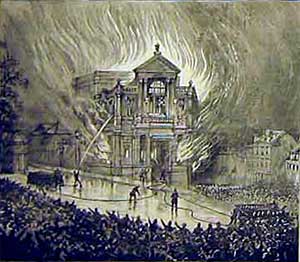 The tragedy that gave birth to the Exeter City Fire
Brigade, the Theatre Royal fire.
The tragedy that gave birth to the Exeter City Fire
Brigade, the Theatre Royal fire.
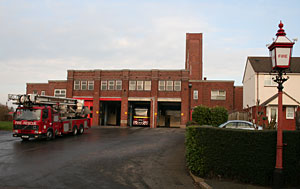 Exeter's Fire Station that was built in 1931 and
demolished in 2008.
Exeter's Fire Station that was built in 1931 and
demolished in 2008.
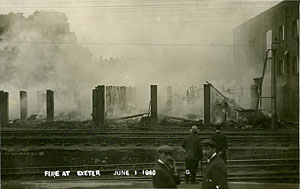 The smoking ruins of Sharpe's Timber Yard destroyed in
June 1910 - see text.
The smoking ruins of Sharpe's Timber Yard destroyed in
June 1910 - see text.
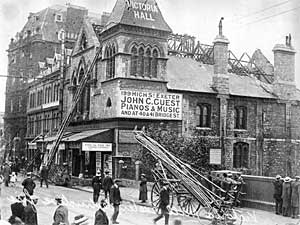 The badly damaged Victoria Hall after the fire of
October 1919 - the hall was situated on the opposite side of the
railway line from Sharpe's Timber Yard. Western Times.
The badly damaged Victoria Hall after the fire of
October 1919 - the hall was situated on the opposite side of the
railway line from Sharpe's Timber Yard. Western Times.
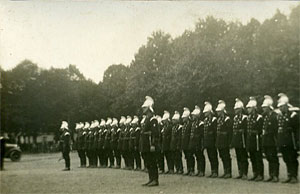 Exeter's Fire Brigade on parade in Belmont Park
sometime in the 1920s.
Exeter's Fire Brigade on parade in Belmont Park
sometime in the 1920s.
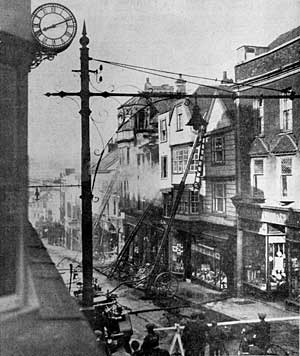 A fire in Fore Street during the 1930s – notice
the two ladders on wheels. Courtesy Express & Echo.
A fire in Fore Street during the 1930s – notice
the two ladders on wheels. Courtesy Express & Echo.
│ Top of Page │